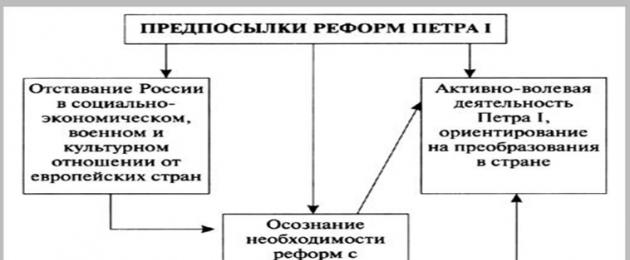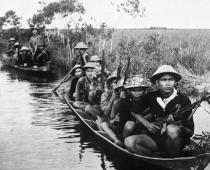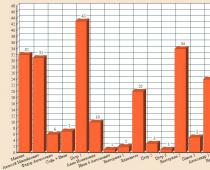Convenient article navigation:
Russia in the era of transformations of Peter I
Considering the personality of the Russian Tsar Peter the Great, most modern historians come to the conclusion that it was this ruler who became the starting point for a new stage in the development of Russia. And all this is due to the extraordinary nature of the monarch, who was not afraid to use the experience of European countries. However, the era of Peter's transformations is, first of all, a period of many reforms that changed the life of Russian society as a whole in a short moment.
Prerequisites for Peter's reforms

Reasons for the transformations of Peter I
Among the main reasons for Peter's reforms, historians especially highlight the following factors that prompted Peter to start reforms:
- Russia's lack of convenient access to the sea, which greatly complicated trade with other states.
- Economic isolation of Russia.
- Lack of large manufactories and industrial production.
- There was no development of trade relations with other countries.
- The parochial system of education did not provide the country with the necessary professional personnel.
- The backlog of Russia in military-technical terms from Western countries.
One of the most important was estate reform, according to which society was officially divided into three main classes:
- city dwellers;
- peasants;
- nobles.
At the same time, the nobles had to perform military service, starting the service with the same ranks as the common people. This suggested that people from the lower classes could receive the highest ranks through their own diligence. The actual order of service degrees was regulated by order of Peter "Table of Ranks", published in 1722 and establishing the fourteen main ranks of civilian and army service.
Interesting fact! Peter personally took part in editing the law, which was based on borrowings from the "schedules of ranks" of the French, Prussian, Swedish and Danish kingdoms.
An important change in peasant life was associated with the so-called tax reform of Peter the Great, which came into effect in 1718, replacing the former household method of taxation. Thus, the poll tax was introduced.
The financial transformation described above had a strong social connotation, because from now on the tax was removed not only from the peasants, but also from privately owned serfs who had not paid taxes before. It was this provision that became decisive for the development of views on serfs as workers, not slaves.
urban reform divided the inhabitants into "irregular" and "regular", and also divided the workshops and guilds by occupation. At the same time, Peter left the cities to choose their burmisters, who were part of the town hall. At the end of the Petrine period, the latter turned into magistrates, who were elected from the "first-class inhabitants" and had more rights.
Transformations in the military sphere
The military transformations of Peter the Great raised the importance of regular regiments, as a result of which the noble militias disappeared completely, and the army itself did not disband after military operations, remaining in a permanent composition.
One of the most important introductions in the Tsar's military reform was creation of a full-fledged Russian fleet, which consisted of eight hundred galleys, forty-eight ships and almost thirty thousand crew.

As state and administrative transformations of the state during the reign of Peter the Great, it is worth highlighting the abolition of the boyars and the system of orders. Also, self-government of volosts and cities actually ceases to exist.
One of the most influential governing bodies was created - Governing Senate, whose members were chosen by the sovereign himself "not by surname, but by knowledge of the matter."
In addition, the former Moscow orders, according to the royal decree of 1718, are replaced according to the Swedish model by a dozen colleges, each of which was in charge of a certain area of \u200b\u200bbusiness (financial control, trade, maritime affairs, etc.). At the same time, the king “takes away” power from the church, subordinating it to the state and abolishes the patriarchate. And the main church organ becomes Holy Synod.
With the next administrative reform, the ruler divides the state into eight separate provinces, which themselves are divided into provinces and counties, headed by governors, governors, or commandants with zemstvo commissars.
In addition to the above, it is worth noting Petrovsky single inheritance law dated 1722, which abolished the usual order of inheritance within the family. At the same time, Peter himself now had the right to choose the one whom he considered necessary for the country to the throne.

During the period of the longest Northern War, to provide for the army, Peter continually introduced new indirect taxes (for example, on stamped paper, beards or oak coffins). In addition, the king cancels the fiat ruble and introduces a penny. Also during this period, the position of profiteers is introduced, indicating to the ruler possible areas for obtaining new funds.
Already at the end of the Petrine period of government, the tax system was significantly transformed. The former household tax is replaced by a poll tax. Like many European rulers of that time, Peter is trying to follow the principles of mercantilism in the economy. He develops industry in every possible way, building factories at the expense of the treasury and assigning serfs to factories and factories.
Interesting fact! At the end of the reign of Peter 1, more than two hundred and thirty factories were operating in Russia.
Returning from a trip to Europe in 1698, the tsar orders the boyars to shave and the nobles to wear European-style clothes to give the country a modern look. In addition, he tries to disseminate knowledge in society and personally edits the first periodical.
Complex church writing is simplified by the alphabet accessible to everyone, the Academy of Sciences and many schools (church and parish) are opened.
Table: transformations of Peter I in the economic sphere

Table: social transformations of Peter I

Table: transformations of Peter I in the field of trade

Table: transformations of Peter I in the field of culture


Table: Results of the transformations of Peter I
The results of the transformations of Peter I |
| The regime of absolutism was established. During the years of his reign, Peter created a state with a more advanced system of government, a strong army and navy, and a stable economy. There was a centralization of power |
| Rapid development of foreign and domestic trade |
| Creation of a regular army and navy |
| The abolition of the patriarchate, the church lost its independence |
| Transformations in the sphere of culture and science contributed to the growth of Russia |
| Strengthening the authority of the state |
Video lecture: The contradictory nature of the transformations of Peter I
- In contact with 0
- Google Plus 0
- OK 0
- Facebook 0








